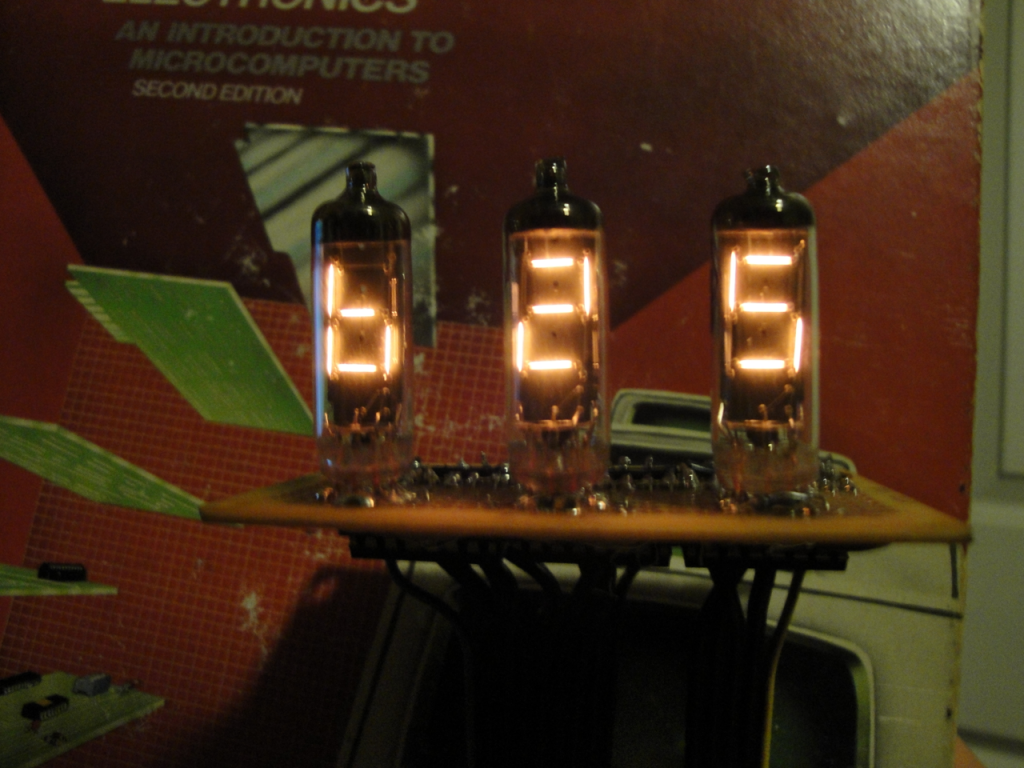The Display
For the display I wanted something more interesting than a simple binary readout. I decided to go with the retro look and use some IV-9 russian Numitron tubes that can be conveniently driven by 5V with 20mA of current, the perfect amount to use a 4511 7-segment decoder. The only problem in the way of a steampunk output for my computer was converting the base-16 output of my computer into 3 digits of base-10 binary coded decimals.
Binary coded decimals are exactly what they sound like. The BCD system uses binary values 0-9 to express the base-10 digits that we use every day. For instance, the binary number 132 (10000100) would be 0001-0011-0010 expressed in binary coded decimal. To convert binary to BCD you can either design an incredibly complicated logic circuit to preform the operation, use a read-only memory (ROM) to output the correct values or use the method I chose of using an Arduino to do the conversion.
My friend and I created an Arduino sketch that takes an 8-bit input (0-255) and outputs 3 BCD digits. The output goes to a 3-digit Numitron readout board that I spent a good amount of time on.
17 Responses to The Display
Leave a Reply Cancel reply
Recent Comments
Archives
Language







That is very cool.
I picked up some of those a few years ago from an EBay seller in Russia. I haven’t gotten around to using them yet but I thought they would look awesome on an 8-Bit Cosmac Elf computer or a TTL CPU project.
I’ll check back later and see how your project shapes up.
Andrew
I like them a lot. I originally bought some similar VFD Numitron tubes from eBay and soon learned that driving 30 volts using 5 volt TTL logic would take far too much time and space on my computer. It’s too bad though, they glowed a brilliant iridescent blue. Did you get IV-9’s? If you get the chance, use them. They are very easy to work with and are straight forward in operation.
Yup, I’m just looking at them now. They are IV-9’s… They look about as easy to work with as a 7-Segment LED display but way cooler retro look.
You bet. I wish that they still manufactured Numitron tubes today, they make such cool displays. Although perhaps their scarcity is what makes them so interesting.
Hi there, You have done a great job. I will certainly digg it and for my part suggest to my friends. I’m sure they’ll be benefited from this website.
[…] He’s aiming for the final product to have a bit of a steampunk aesthetic, including a steampunk case, and an already built Numitron tube display. […]
[…] He’s aiming for the final product to have a bit of a steampunk aesthetic, including a steampunk case, and an already built Numitron tube display. […]
[…] He’s aiming for the final product to have a bit of a steampunk aesthetic, including a steampunk case, and an already built Numitron tube display. […]
[…] He’s aiming for the final product to have a bit of a steampunk aesthetic, including a steampunk case, and an already built Numitron tube spectacle. […]
[…] He’s aiming for the final product to have a bit of a steampunk aesthetic, including a steampunk case, and an already built Numitron tube display. […]
I’ll check back later and see how your project shapes up.
Websites we think you should visit…
we like to honor many other internet sites on the web, even if they aren’t linked to us, by linking to them. Under are some webpages worth checking out…
In the second paragraph you have a typo. You have written “132 (1000 0010)” but it must be “132 (1000 0100)”
Thanks for sharing your awesome project.
Thank you kindly for the correction, I changed it to the correct value. And I’m glad that you enjoyed my project.
Was 74185 not available, since you decided to put a much more complicated processor to drive the display?
I mean this chip – datasheet:
http://www.utm.edu/staff/leeb/DM74185.pdf
and one vendor that claims to stock it: http://www.littlediode.com/components/74158.html
Hey , How did u compiled this code? how did you use those functions ? are they predefined somewhere. how can this code work ?